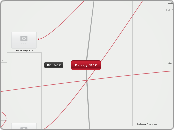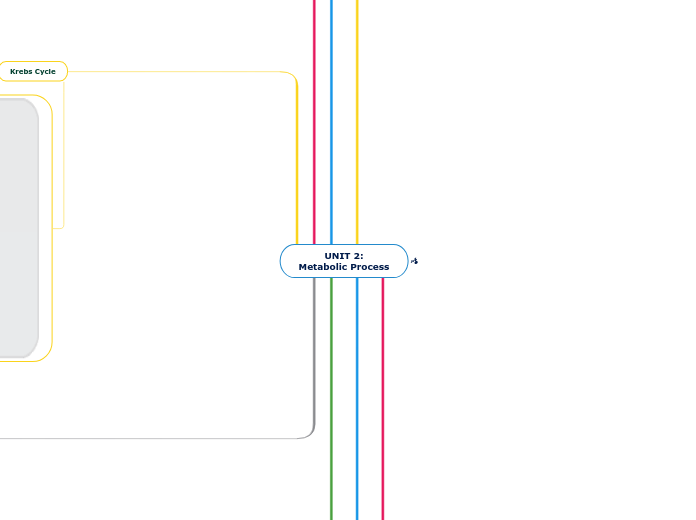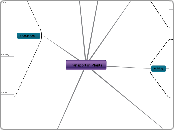Biology 311C
Big Idea 2
Photosynthesis
NADPH
Photosystem 1
Energy from ETC in Photosystem 2 transfers to Photosystem 1
ETC Energy Excites P700
Cyclic Electron Flow
The plant process switches to Cyclic Electron Flow when enough NADPH is made within the cell
The plant produces ATP
Ferredoxin
Cytochrome Complex
Light Replaces P700 Energy
ETC
Photosystem 2
Light
Pigment Molecule
P680
H2O
Primary Acceptor
Electron Transport Chain
ATP
Cellular Respiration
Aerobic
Glycolysis occurs in the cytosol and Krebs Cycle occurs within the Mitochondria
Totals
10 NADH
4 ATP
Krebs Cycle (Energy Payoff)
2 FADH2
1 FADH2 per Acetyl CoA
6 NADH
3 NADH per Acetyl CoA
1 ATP per Acetyl CoA
2 Acetyl CoA
Enters Mitochondrion
Acetyl CoA
Pyruvate cannont enter Krebs Cycle
It is converted into Acetyl CoA by removing CO2 and transfering an electron with energy to NAD+ to make NADH.
Since 2 pyruvate are formed, 2 NADH are formed and 2 Acetyl CoA are made
Oxaloacetate
Acetyl CoA attaches to Oxaloacetate 1 at a time!!!
Produces the molecule Citrate
Isocitrate
Citrate is converted into Isocitrate by dehydration process.
Isocitrate loses energy to NAD+ to make NADH.
It also loses CO2.
Molecule becomes a-Ketoglutarate
Becomes oxidized, makes another NADH and loses another CO2.
Molecule becomes Succinyl CoA.
ATP Generation
The Co-A group is removed By the addition of a phosphate which is then removed to be added to GDP to make GTP which is then transfers it's phosphate to ADP to make ATP.
The remaining molecule after the production of ATP is Succinate which transfers 2 electrons to FAD to make FADH2 becoming Fumarate which gains water to become Malate which is unstable enough to oxidize and make another NADH to end/ start the cycle with another oxaloacetate.
Glycolysis (Energy Investment)
2 Pyruvate
4 ATP Used
Oxidation
Split: 2 (3) Carbon Sugars
Glucose
Reactant: 6 Carbon Glucose Sugar Molecule
Hexokinase
Hexokinase transfers a phosphate group from ATP to glucose, making it unstable (traps glucose in the cell)
Molecule becomes: Glucose 6-phosphate
Enters enzyme: Phosphogluco-isomerase
converts Glucose 6-phosphate to its isomer
Molecule becomes: Fructose 6-phosphate
Phosphofructokinase
Adds phosphate to Fructose 6-phosphate from ATP in the cell making it very unstable
(can be used for regulation)
Molecule becomes: Fructose 1,6-bisphosphate
Enters Adolase: Makes 2 molecules one of which is converted to be like the other forming 2 molecules of Glyceraldehyde 3-phosphate
Triose Phosphate Dehydrogenase
Enzyme oxidizes molecules transfering the 2 electrons to NAD+ to from 2 NADH (electron carrier: energy carrier)
and 2 H+ ions
Attaches a phsphate to make it unstable
Molecule becomes: 1,3-bisphosphogylerate
Phosphoglycerokinase
Enzyme uses the phosphates from previous molecule to make 2 ATP (substrate level phosphorylation)
A substrate (1,3-bisphophoglycerate) synthesized the production of ATP.
Molecule becomes: 3-Phosphoglycerate
Phosphoenol-Pyruvate(PEP)
3-Phosphoglycerate enters phosphoglyceromutase which moves the phosphate group around to make the molecule unstalbe
Molecule becomes: 2-phosphoglycerate
Enters enolase wich forms a double bond in the R - Group by extracting water making
Pohsphoenolpyruvate (PEP) Super unstable and HIGH Energy
PEP enters the enzyme Pyruvate Kinase which transfers a phosphate from PEP to ADP to make 2 ATP (Another Substrate Level Phosphorylation)
Final: 2 molecules of Pyruvate
4 ATP produced - 2 used: 2 ATP Yield
2 NADH Yield
2 Pyruvate
Anaerobic
Fermentation
Pyruvate
Lactic Acid
2 Lactate
2 Pyruvate gain 2H+ ions from the 2 NADH made in Glycolysis to make 2 NAD+ and 2 Lactate
Alcohol
2 Ethanol
2 NADH
Both used to make Ethanol producing 2 NAD+
2 ATP
CO2
Pyruvate loses 2 CO2 to make 2 Acetaldehyde
Acetaldehyde
Acetaldehyde gains 2 H+ ions from the 2 NADH made in Glycolysis to produce 2 NAD+ and the 2 H+ions attach to the 2 Acetaldehyde to make 2 Ethanol
Ethanol
Big Idea 3
Translation
Eukaryotic
5'Cap leads mRNA out of Nucleus
Attaches to Ribosome
tRNA attaches amino acid bases to poypeptide chain
Occurs With Transcription
No Cap or Tail
Transcription
Pre-mRNA
Exon 1
snRNPs
Spliceosome
Intron
Exon 2
5' Cap
Stop Codon
Polyadenylation Signal
Poly - A Tail
Promoter (TATA Box)
Start Codon
Transcription Factors
Prokaryotic
mRNA
Shine Dalgarno
RNA Polymerase 2
DNA & Replication
Replication
Prokaryotes
Occurs in the Cytosol
Parts
DNA Polymerase 1
Replaces the RNA with DNA
DNA Polymerase 3
Adds DNA nucleotides to RNA primer 5'-3'
Okazaki Fragments
RNA Primase
Enzyme that synthesises RNA Primer Chain
Primer
RNA chain that adds RNA nucleoides
Topoisomerase
Breaking, Swiveling, & Rejoining of tangled DNA Strand Upstream
Helicase
Enzyme unwinds helix to create template strands
Replication Fork
Where parental strands are being unwound
Origin of Replication
Specific Sequence of DNA nucleotides
Models
Dispersive
Semiconservative
Conservative
Structure
Double Helix
Phosphate Group
Pentose Sugar Deoxyribose
Nitrogenous Base
James Watson & Francis Crick
Nucelotide Bases
C=19.9%
Pyrimidines
G=19.6%
T=30.1%
A=30.4%
Purine
Big Idea 1
Biological Membrane
Biological Molecules
Nucleic Acids
RNA
Uracil
Adenine
Single Strand
2 Carbon & OH Group
Amino Acids
Thymine
Cytosine
Guanine
Adenine
Double Strand
2 Carbon & H Group
Carbohydrates
Monosacharides
Lipids
Nonpolar Molecules
Steroids
Phospholipids
Fats
Proteins
Enzymes
Amino Acids
Protein Structure
Quaternary
Tertiary
Secondary
Primary
Chaperonin
Cellular Transportation
Exocytosis
Co-Transport
Voltage-Electrical Potential Energy
Electrochemical Gradient
Electrical Force
Chemical Force
Membrane Potential
Electrical Potential
Exterior Membrane
Interior Membrane
Active Transport
Carrier Proteins
Aqua Porins
Diffusion
Facillitated Diffusion
Osmosis
Tonicity
Hypotonic
Hypertonic
Isotonic
Passive Transport
Cholesterol
Glycolipids
Globular Protein
Phosphlipid Bilayer
Cell Structure
Plant
Microtubuole
Plasma Membrance
Chloroplast
Inner Membrane Space
Stroma
Granum
Thylakoid
Thylakoid Space
Plasmodesmata
Vacuole
Eukaryotic
Mitochondria
Outer Membrane
Inner Membrane
Inter Membrane Space
Cristae
Matrix
DNA
ATP Synthase Particles
Flagella
Centosome
Microvilli
Micro-Fillaments
Peroxisome
Lysosome
Golgi
Endoplasmic Reticulum
Rough E. R.
Smooth E. R.
Nucleus
Prokaryotic
Cell Membrane
Capsule
Flagellum
Pilli
Cystoplasm
Granule
Ribosome
Plasmid
Nucleoid
Hierarchy of Life
Atom
Molecule
Organelle
Cell
Tissue
Organ
Organ System
Organism
Classification
Species
Genus
Family
Order
Class
Phylum
Kingdom
Domain
Humans
4%
Magnesium
Chlorine
Sodium
Sulfur
Potassium
Phosphorous
Calcium
96%
Nitrogen
Hydrogen
Carbon
Oxygen
Popullation
Community
Ecosystem
Domains of Life
Eukarya
Archaea
Bacteria
Biosphere









